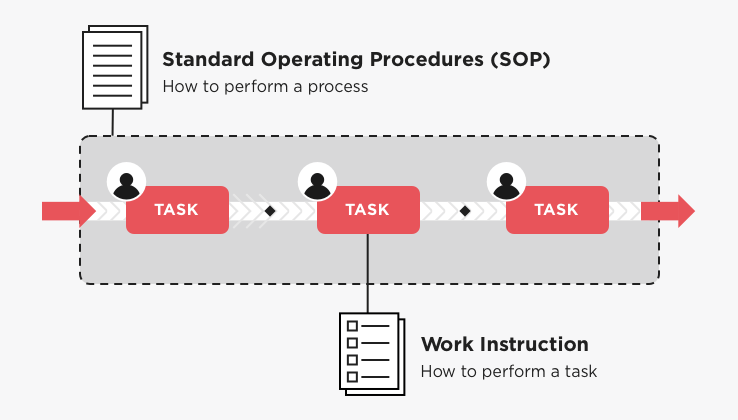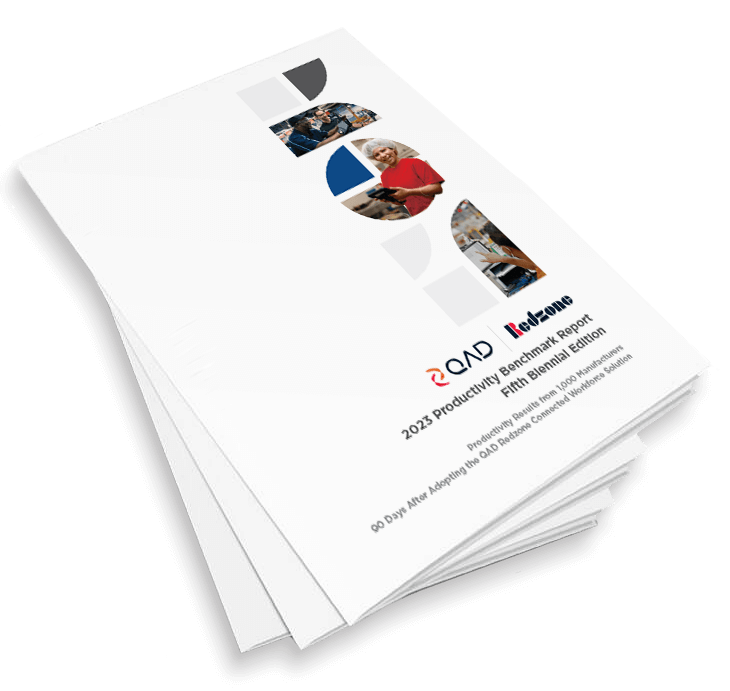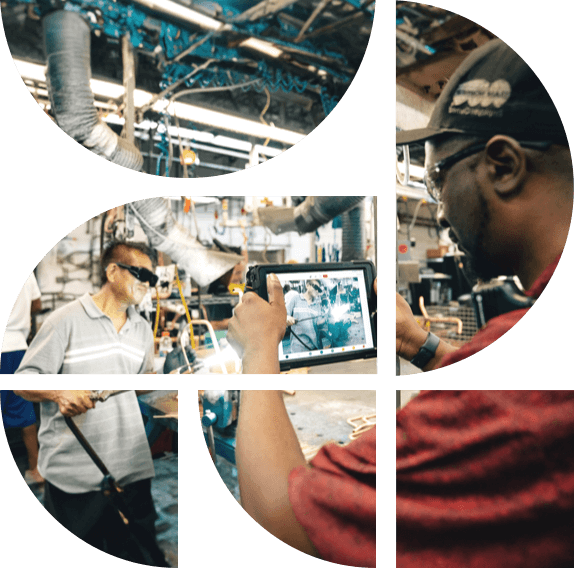Press Release: QAD Redzone is Front Runner in LNS Research Connected Frontline Workforce Applications Solution Selection Matrix Read Now
Ken Fisher
October 10, 2023

In manufacturing, the consistent and precise execution of tasks is crucial. Two essential tools — standard operating procedures (SOPs) and work instructions — lie at the heart of this operational consistency. Although these terms are often used interchangeably, understanding the differences between them can significantly enhance your production process.
Both SOPs and work instructions contribute to safe and streamlined operations, aiding in risk minimization and quality maintenance. However, they differ in the level of detail they provide and their application within the production process.
Continue reading to explore SOP vs work instructions, their unique roles, how they compare and the importance of their effective management.
SOPs are essentially well-structured written guidelines that lay out a sequence of steps necessary for the consistent execution of routine operations. Adherence to SOPs is critical, as they ensure a company maintains its operational consistency and remains compliant with industry standards and regulations.
In a manufacturing context, SOPs play a vital role in:
Work instructions are precise, detailed sets of instructions that guide the workforce through complex tasks. They’re designed to help teams accurately build, package, label and ship products that meet predefined specifications. Regardless of whether a company mass produces a single item or alternates between different goods, formulating clear and precise work instructions is vital for success.
The role of work instructions in manufacturing is multifaceted:

While both SOPs and work instructions serve as guiding documents in a manufacturing environment, their applications and purposes vary significantly. Here’s a closer look at the key distinguishing factors:
SOPs generally provide an overview of broad processes or procedures within a manufacturing operation. They describe how various tasks and activities should be carried out to achieve a particular outcome or to maintain a certain standard.
Work instructions, on the other hand, are more narrow in scope, focusing on specific tasks within the broader process. They provide explicit instructions for a particular activity, ensuring it is performed correctly and consistently.
Work instructions provide a higher level of detail compared to SOPs. They offer step-by-step guidance, often breaking down complex tasks into manageable, easily understandable parts.
SOPs, while detailed, tend to be more general, offering a high-level overview of the process rather than delving into specifics of individual tasks.
SOPs are typically more formal and text-heavy. They might include flowcharts or diagrams, but their primary medium is text.
Work instructions often employ a range of media to convey directions as clearly as possible. In addition to text, they might include photos, videos, diagrams or other visual aids to help workers understand and perform the task at hand.
SOPs are usually intended for a managerial audience. They offer guidelines for supervisors or managers on how to orchestrate and oversee various operational processes.
In contrast, work instructions are primarily targeted at operators or line workers — individuals directly involved in carrying out the tasks.
Efficient management of SOPs and work instructions is essential in a manufacturing environment. Their proper organization, maintenance and implementation directly contribute to enhanced productivity and performance. Here are key reasons why their management is critical:
Proper management ensures that all procedures are carried out as per the established guidelines, significantly reducing operational risks and non-compliance issues.
When clearly defined and easily accessible, SOPs and work instructions prevent misunderstandings and errors in task execution. They provide precise guidance, leaving no room for doubt.
Having well-managed SOPs and work instructions reduces the impact when key personnel leave. New team members can get up to speed quickly by referring to these detailed documents.
SOPs and work instructions save time by providing a roadmap for processes and tasks. There’s no need to “reinvent the wheel” each time a task is performed.
Failure to manage SOPs and work instructions can result in numerous issues. Miscommunication, operational errors, decreased productivity and inconsistencies in product quality are just some of the potential problems. In worst-case scenarios, non-compliance with industry regulations could lead to legal ramifications. Hence, the need for efficient management cannot be overstated.
The digitization of work instructions offers transformative potential for manufacturing processes. It presents an opportunity to amplify efficiency, bolster accuracy and ensure compliance with industry standards. The emergence of specialized software solutions, such as QAD Redzone, has made this shift more feasible and advantageous.
Key features and benefits of using a solution like QAD Redzone include:
Digital work instructions are easy to access, update and disseminate. This feature ensures that every team member always has the most current information.
QAD Redzone supports the integration of text, images, videos and interactive elements, making work instructions more comprehensive and easier to follow.
The software allows for easy tracking of changes and updates, ensuring traceability. This feature is particularly helpful for maintaining compliance with industry regulations.
Digitization eliminates the need for physical documentation, leading to more efficient processes. Digital work instructions are easily searchable, reducing the time it takes to find information and thereby improving productivity.
Embracing a software solution such as QAD Redzone to manage work instructions can greatly enhance operational efficiency, reduce errors and ensure smoother, more compliant manufacturing processes.
Dot’s Pretzels, a popular snack manufacturing company, provides a powerful example of the transformative impact of QAD Redzone on shopfloor performance. Their journey with QAD Redzone illustrates the immense potential of effectively managed processes and procedures.
Before QAD Redzone, Dot’s Pretzels struggled with measuring productivity, engaging employees effectively, managing compliance and preparing for SQF audits. Traditional methods of maintaining SOPs and work instructions created hurdles for efficient operations and clear communication among team members, particularly those speaking different languages.
The implementation of QAD Redzone at Dot’s Pretzels introduced a reliable, accessible system to measure productivity, engage staff and manage compliance. The software became a source of pride and a tool to promote staff accomplishments, all while providing invaluable data and streamlined SOPs and work instructions right at their fingertips.
Post-implementation, Dot’s Pretzels experienced significant improvements, including:
Furthermore, QAD Redzone helped enhance the inclusivity of the workplace. One employee, Robin Caylor, proposed adding Spanish translations to huddles, facilitating clear communication with new Spanish-speaking team members. With QAD Redzone, she could also suggest new downtime codes to ensure accurate tracking of any issues, further refining the company’s SOPs.
Thanks to these changes, her line saw a productivity improvement of 56%. These results led to Dot’s Pretzels winning a 2021 Productivity Award.
Dot’s Pretzels’ success with QAD Redzone exemplifies the benefits of embracing key strategies, such as:
The case of Dot’s Pretzels underlines the profound impact QAD Redzone can have on enhancing shop floor performance — particularly through the effective use and management of digital SOPs and work instructions.
Final Thoughts
Recognizing the difference between SOPs and work instructions is essential in manufacturing. SOPs establish broad operational standards, while work instructions guide detailed tasks to minimize errors and ensure safety.
Efficiently managing these tools is vital but can be challenging with traditional methods. QAD Redzone, as a digital solution, simplifies this process, boosting efficiency, accuracy and compliance.
Understanding SOPs and work instructions — along with a robust digital system like Redzone — can greatly enhance manufacturing shop floor performance, as demonstrated in the case of Dot’s Pretzels.
To experience these benefits firsthand, reach out to QAD Redzone today. Discover how we can help transform your business and elevate your shop floor performance.
Contact us today to start your journey to operational excellence.
Ken Fisher Ken Fisher, SVP Product, Marketing, and Solutions at Redzone, is a seasoned professional with over 20 years of experience in manufacturing operations and lean transformation. He has a deep understanding of industry challenges and is dedicated to recognizing the value of frontline workers in manufacturers' success. Ken leads a team at Redzone that enhances current products, develops new solutions, and works with factories to design digital production systems that achieve operational goals. He also served as a Continuous Improvement Coach, implementing Redzone in food processing facilities. Notably, Ken spoke at the Food Safety Summit in 2019. He holds a B.S. in Industrial Engineering from the University of South Florida and an M.B.A. from the University of Florida.
1,000 Factories’ Productivity Data: The Largest Dataset of Its Kind ...

Contact us and let's begin empowering your frontline and growing your bottomline.
